Attention
TYPO3 v7 has reached its end-of-life November 30th, 2018 and is not maintained by the community anymore. Looking for a stable version? Use the version switch on the top left.
There is no further ELTS support. It is recommended that you upgrade your project and use a supported version of TYPO3.
TYPE: "select"¶
Selectors boxes are very common elements in forms. By the "select" type you can create selector boxes. In the most simple form this is a list of values among which you can chose only one. In that way it is similar to the "radio" type above.
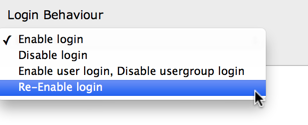
A simple selector box with a few options¶
More complex configurations are possible, see the examples section for more details.
Properties¶
Property |
Data Type |
|---|---|
boolean |
|
string |
|
string |
|
integer |
|
string |
|
boolean |
|
string |
|
boolean |
|
string |
|
string |
|
string |
|
string |
|
string |
|
string |
|
string |
|
string |
|
array |
|
string |
|
boolean |
|
integer |
|
integer |
|
boolean |
|
array |
|
array |
|
string |
|
array |
|
string |
|
string |
|
boolean |
|
array |
|
string |
|
boolean |
|
string |
|
integer |
|
boolean |
|
integer |
|
string |
|
array |
|
string |
|
array |
Property details¶
items¶
Key
items
Datatype
array
Description
Contains the elements for the selector box unless the property "foreign_table" or "special" has been set in which case automated values are set in addition to any values listed in this array.
Each element in this array is in itself an array where:
First value is the item label (string or LLL reference)
Second value is the value of the item .
The special value
--div--is used to insert a non-selectable value that appears as a divider label in the selector box (only for maxitems <=1)Values must not contain "," (comma) and "|" (vertical bar). If you want to use "authMode" you should also refrain from using ":" (colon).
Third value is an optional icon. Default path is
typo3/sysext/t3skin/icons/gfx/but is deprecated since TYPO3 CMS 7, and will be removed with TYPO3 CMS 8. For custom icons use a path prepended with "EXT:" to refer to an image file found inside an extension or use an registered icon identifier.Fourth value is an optional description text. This is only shown when the list is shown by renderType
selectCheckBox.Fifth value is reserved as keyword "EXPL_ALLOW" or "EXPL_DENY". See option "authMode" / "individual" for more details.
Note
Usage of path in the third property is deprecated. For custom icons use a path prepended with "EXT:" to refer to an image file found inside an extension or use an registered icon identifier, which is the prefered way.
Example:
A configuration could look like this:
'type' => 'select',
'items' => array(
array('English', ''),
array('Danish', 'dk'),
array('German', 'de'),
)
A more complex example could be this (includes icons):
'type' => 'select',
'items' => array(
array('LLL:EXT:cms/locallang_ttc.php:k1', 0, 'EXT:myext/Resources/Public/selicons/k1.gif'),
array('LLL:EXT:cms/locallang_ttc.php:k2', 1, 'tx-myext-selicons-k2'),
array('LLL:EXT:cms/locallang_ttc.php:k3', 2, 'tx-myext-selicons-k3'),
)
Scope
Display
itemsProcFunc¶
Key
itemsProcFunc
Datatype
string
(function reference)
Description
PHP function which is called to fill / manipulate the array with elements.
The function/method will have an array of parameters passed to it (where the item-array is passed by reference in the key 'items'). By modifying the array of items, you alter the list of items. Since TYPO3 CMS 6.2, your function/method may throw an exception which will be displayed as a proper error message.
For more information, see how user-functions are specified in the section about wizards some pages below here.
Scope
Display
selicon_cols¶
Key
selicon_cols
Datatype
integer (>0)
Description
The number of rows in which to position the icons for the selector box. Default is to render as many columns as icons.
Scope
Display
showIconTable¶
Key
showIconTable
Datatype
boolean
Description
Controls the rendering of the icons after the select even when icons
for the <select>'s <option> tags were supplied.
Scope
Display
foreign_table¶
Key
foreign_table
Datatype
string
(table name)
Description
The item-array will be filled with records from the table defined
here. The table must be configured in $TCA.
See the other related options below.
Scope
Proc. / Display
foreign_table_where¶
Key
foreign_table_where
Datatype
string
(SQL WHERE clause)
Description
The items from foreign_table are selected with this WHERE-clause.
The table is joined with the "pages"-table and items are selected only from pages where the user has read access! (Not checking DB mount limitations!)
Example:
AND [foreign_table].pid = 0 ORDER BY [foreign_table].sorting
Markers:
You can use markers in the WHERE clause:
###REC_FIELD_[field name]### - Any field of the current record.
Note
The field name part of the marker is not in upper case letters. It must match the exact case used in the database.
###THIS_UID### - is current element uid (zero if new).
###CURRENT_PID### - is the current page id (pid of the record).
###SITEROOT###
###PAGE_TSCONFIG_ID### - a value you can set from Page TSconfig dynamically.
###PAGE_TSCONFIG_IDLIST### - a value you can set from Page TSconfig dynamically.
###PAGE_TSCONFIG_STR### - a value you can set from Page TSconfig dynamically.
The markers are preprocessed so that the value of CURRENT_PID and PAGE_TSCONFIG_ID are always integers (default is zero), PAGE_TSCONFIG_IDLIST will always be a comma-separated list of integers (default is zero) and PAGE_TSCONFIG_STR will be addslashes'ed before substitution (default is blank string).
More information about markers set by Page TSconfig can be found in the TSconfig reference.
See example below "Simple selector box with TSconfig markers".
Scope
Proc. / Display
foreign_table_prefix¶
Key
foreign_table_prefix
Datatype
string or LLL reference
Description
Label prefix to the title of the records from the foreign-table.
Scope
Display
fileFolder¶
Key
fileFolder
Datatype
string
Description
Specifying a folder from where files are added to the item array.
Specify the folder relative to the PATH_site, possibly using the prefix "EXT:" to point to an extension folder.
Files from the folder is selected recursively to the level specified by fileFolder_recursions and only files of the extension defined by fileFolder_extList is selected.
Only the file reference relative to the "fileFolder" is stored.
If the files are images (gif,png,jpg) they will be configured as icons (third parameter in items array).
Example:
'config' => array (
'type' => 'select',
'items' => array (
array('', 0),
),
'fileFolder' => 'EXT:cms/tslib/media/flags/',
'fileFolder_extList' => 'png,jpg,jpeg,gif',
'fileFolder_recursions' => 0,
'selicon_cols' => 8,
'size' => 1,
'minitems' => 0,
'maxitems' => 1,
)
Scope
Display / Proc
fileFolder_extList¶
Key
fileFolder_extList
Datatype
string
Description
List of extensions to select. If blank, all files are selected. Specify list in lowercase.
See \TYPO3\CMS\Core\Utility\GeneralUtility::getAllFilesAndFoldersInPath().
Scope
Display / Proc
fileFolder_recursions¶
Key
fileFolder_recursions
Datatype
integer
Description
Depth of directory recursions. Default is 99. Specify in range from 0-99.
0 (zero) means no recursion into subdirectories.
See \TYPO3\CMS\Core\Utility\GeneralUtility::getAllFilesAndFoldersInPath().
Scope
Display / Proc
allowNonIdValues¶
Key
allowNonIdValues
Datatype
boolean
Description
If "foreign_table" is enabled:
If set, then values which are not integer ids will be allowed. May be needed if you use itemsProcFunc or just enter additional items in the items array to produce some string-value elements for the list.
Notice: If you mix non-database relations with database relations like this, DO NOT use integers for values and DO NOT use "_" (underscore) in values either!
Notice: Will not work if you also use "MM" relations!
Scope
Proc.
default¶
Key
default
Datatype
string
Description
Default value.
If empty, the first element in the items array is selected.
Scope
Display / Proc.
dontRemapTablesOnCopy¶
Key
dontRemapTablesOnCopy
Datatype
string
Description
(See same feature for type="group")
Set it to the exact same value as foreign_table if you don't want values to be remapped on copy.
Scope
Proc.
rootLevel¶
Key
rootLevel
Datatype
boolean
Description
If set, the foreign_table_where will be ignored and a "pid=0" will be added to the query to select only records from root level of the page tree.
Scope
Display
MM¶
Key
MM
Datatype
string
(table name)
Description
Means that the relation to the records of foreign_table is done with a M-M relation with a third "join" table.
That table has three columns as a minimum:
uid_local, uid_foreign for uids respectively.
sorting is a required field used for ordering the items
sorting_foreign is required if the relation is bidirectional (see description and example below table)
tablenames is used if multiple tables are allowed in the relation.
uid (auto-incremented and PRIMARY KEY) may be used if you need the "multiple" feature (which allows the same record to be references multiple times in the box. See MM_hasUidField.
Other fields may exist, in particular if MM_match_fields is involved in the set up.
Example SQL #1: (most simple MM table)
CREATE TABLE user_testmmrelations_one_rel_mm (
uid_local int(11) DEFAULT '0' NOT NULL,
uid_foreign int(11) DEFAULT '0' NOT NULL,
sorting int(11) DEFAULT '0' NOT NULL,
KEY uid_local (uid_local),
KEY uid_foreign (uid_foreign)
);
Example SQL #2 (Advanced with UID field, "ident" used with MM_match_fields and "sorting_foreign" for bidirectional MM relations):
#
# Table structure for table 'user_testmmrelations_two_rel_mm'
#
#
CREATE TABLE user_testmmrelations_two_rel_mm (
uid int(11) NOT NULL auto_increment,
uid_local int(11) DEFAULT '0' NOT NULL,
uid_foreign int(11) DEFAULT '0' NOT NULL,
tablenames varchar(30) DEFAULT '' NOT NULL,
sorting int(11) DEFAULT '0' NOT NULL,
sorting_foreign int(11) DEFAULT '0' NOT NULL,
ident varchar(30) DEFAULT '' NOT NULL,
KEY uid_local (uid_local),
KEY uid_foreign (uid_foreign),
PRIMARY KEY (uid),
);
The field name of the config is not used for data-storage anymore but rather it's set to the number of records in the relation on each update, so the field should be an integer.
Note
Using MM relations you can ONLY store real relations for foreign tables in the list - no additional string values or non-record values.
MM relations and flexforms
MM relations has been tested to work with flexforms if not in a repeated element in a section. See example below.
Scope
Proc.
MM_opposite_field¶
Key
MM_opposite_field
Datatype
string
(field name)
Description
If you want to make a MM relation editable from the foreign side
(bidirectional) of the relation as well, you need to set
MM_opposite_field on the foreign side to the field name on the local
side.
E.g. if the field "companies.employees" is your local side and you
want to make the same relation editable from the foreign side of the
relation in a field called persons.employers, you would need to set
the MM_opposite_field value of the TCA configuration of the
persons.employers field to the string "employees".
Note
Bidirectional references only get registered once on the native side in "sys_refindex".
Scope
Proc.
MM_match_fields¶
Key
MM_match_fields
Datatype
array
Description
Array of field=>value pairs to both insert and match against when writing/reading MM relations.
Scope
Display / Proc.
MM_oppositeUsage¶
Key
MM_oppositeUsage
Datatype
array
Description
(Since TYPO3 CMS 6.2)
In a MM bidirectional relation using match fields the opposite side needs to know about the match fields for certain operations (for example, when a copy is created in a workspace) so that relations are carried over with the correct information.
MM_oppositeUsage is an array which references which
fields contain the references to the opposite side, so that they
can be queried for match field configuration.
This is used by the Core for system categories. Whenever a table
is registered as being categorizable, an entry in MM_oppositeUsage
is created for the "sys_category" table.
Example
With "pages", "tt_content" and "sys_file_metadata" all registered as categorizable (using the default name of "categories" for the relations field) plus extension "examples" installed, the TCA for "sys_category" contains the following definition once fully assembled:
$GLOBALS['TCA']['sys_category']['columns']['items']['config']['MM_oppositeUsage'] = array(
'pages' => array('tx_examples_cats', 'categories'),
'sys_file_metadata' => array('categories'),
'tt_content' => array('categories'),
)
Scope
Proc.
MM_insert_fields¶
Key
MM_insert_fields
Datatype
array
Description
Array of field=>value pairs to insert when writing new MM relations
Scope
Proc.
MM_table_where¶
Key
MM_table_where
Datatype
string (SQL WHERE)
Description
Additional where clause used when reading MM relations.
Scope
Display
MM_hasUidField¶
Key
MM_hasUidField
Datatype
boolean
Description
If the "multiple" feature is used with MM relations you MUST set this value to true and include a UID field! Otherwise sorting and removing relations will be buggy.
Scope
Proc.
special¶
Key
special
Datatype
string
(any of keywords)
Description
This configures the selector box to fetch content from some predefined internal source. These are the possibilities:
tables - the list of TCA tables is added to the selector (excluding "adminOnly" tables).
pagetypes - all "doktype"-values for the "pages" table are added.
exclude - the list of "excludeFields" as found in $TCA is added.
modListGroup - module-lists added for groups.
modListUser - module-lists added for users.
explicitValues – List values that require explicit permissions to be allowed or denied. (See authMode).
languages – List system languages ("sys_language" records from page tree root + Default language)
custom – Custom values set by backend modules (see
TYPO3_CONF_VARS[BE][customPermOptions])
As you might have guessed these options are used for backend user management and pretty worthless for most other purposes.
Scope
Display / Proc.
autoSizeMax¶
Key
autoSizeMax
Datatype
integer
Description
If set, then the height of multiple-item selector boxes (maxitems > 1) will automatically be adjusted to the number of selected elements, however never less than "size" and never larger than the integer value of "autoSizeMax" itself (takes precedence over "size"). So "autoSizeMax" is the maximum height the selector can ever reach.
Scope
Display
selectedListStyle¶
Key
selectedListStyle
Datatype
string
Description
If set, this will override the default style of the selector box with selected items (which is "width:200px").
Applies for when maxitems is > 1
Scope
Display
itemListStyle¶
Key
itemListStyle
Datatype
string
Description
If set, this will override the default style of the selector box with available items to select (which is "width:200px").
Applies for when maxitems is > 1
Scope
Display
renderType¶
Key
renderType
Datatype
string (any of keywords)
Description
This setting specifies how the select field should be displayed. Available options are:
selectSingle- Normal select field for selecting a single value.selectSingleBox- Normal select field for selecting multiple values.selectCheckBox- List of checkboxes for selecting muliple values.selectMultipleSideBySide- Two select fields, items can be selected from the right field, selected items are displayed in the left select.selectTree- A tree for selecting hierarchical data.
Note
Properties "maxitems" and "minitems" are not enforced in the browser for any of the render types here! However they will be on the server. It is recommended to set "minitems" to zero and "maxitems" to a very large number exceeding the possible number of values you can select (for instance set it to 1000 or so).
Scope
Display
treeConfig¶
Key
treeConfig
Datatype
(configuration options)
Description
Configuration if the renderType
is set to "selectTree". Either childrenField or parentField
has to be set - childrenField takes precedence.
Sub-properties:
dataProvider: Allows to define a custom data provider class for usecases where special data preparation is necessary. By default
\TYPO3\CMS\Core\Tree\TableConfiguration\DatabaseTreeDataProvideris used.childrenField (string) : Field name of the foreign_table that references the uid of the child records (either child
parentField (string) : Field name of the foreign_table that references the uid of the parent record
rootUid (integer, optional) : uid of the record that shall be considered as the root node of the tree. In general this might be set by Page TSconfig
appearance (array, optional) :
showHeader (boolean) : Whether to show the header of the tree that contains a field to filter the records and allows to expand or collapse all nodes
expandAll (boolean) : Whether to show the tree with all nodes expanded
maxLevels (integer) : The maximal amount of levels to be rendered (can be used to stop possible recursions)
nonSelectableLevels (list, default "0") : Comma-separated list of levels that will not be selectable, by default the root node (which is "0") cannot be selected
allowRecursiveMode (boolean) : If set to
true, the selection of a node will trigger the selection of all child nodes too (recursively).width (since TYPO3 CMS 6.0): Set a custom width of the tree select field in pixels.
Scope
Display
multiple¶
Key
multiple
Datatype
boolean
Description
Allows the same item more than once in a list.
If used with bidirectional MM relations it must be set for both the native and foreign field configuration. Also, with MM relations in general you must use a UID field in the join table, see description for "MM"
Scope
Display / Proc.
maxitems¶
Key
maxitems
Datatype
integer > 0
Description
Maximum number of items in the selector box. (Default = 1)
Note
Property maxitems is ignored if renderType selectSingle is set.
Scope
Display / Proc
minitems¶
Key
minitems
Datatype
integer > 0
Description
Minimum number of items in the selector box. (Default = 0)
Scope
Display
disableNoMatchingValueElement¶
Key
disableNoMatchingValueElement
Datatype
boolean
Description
If set, then no element is inserted if the current value does not match any of the existing elements. A corresponding options is also found in Page TSconfig.
Scope
Display
enableMultiSelectFilterTextfield¶
Key
enableMultiSelectFilterTextfield
Datatype
boolean
Description
(Since TYPO3 CMS 6.2)
If set, a textual field is shown above the available items in which one can type words to filter the list of available items.
Applies only when maxitems is > 1.
Scope
Display
multiSelectFilterItems¶
Key
multiSelectFilterItems
Datatype
array
Description
(Since TYPO3 CMS 6.2)
Contains predefined elements for the filter field enabled by enableMultiSelectFilterTextfield. On selecting a item, the list of available items gets automatically filtered.
Each element in this array is in itself an array where:
First value is the filter value of the item .
Second value is the item label (string or LLL reference)
Example:
A configuration could look like this:
'related_content' => array(
'label' => 'LLL:EXT:examples/Resources/Private/Language/locallang_db.xlf:tx_examples_haiku.related_content',
'config' => array(
'type' => 'select',
'foreign_table' => 'tt_content',
'foreign_table_where' => 'ORDER BY header ASC',
'size' => 5,
'minitems' => 0,
'maxitems' => 999,
'enableMultiSelectFilterTextfield' => TRUE,
'multiSelectFilterItems' => array(
array(
'image',
'LLL:EXT:examples/Resources/Private/Language/locallang_db.xlf:tx_examples_haiku.related_content.image'
),
array(
'typo3',
'LLL:EXT:examples/Resources/Private/Language/locallang_db.xlf:tx_examples_haiku.related_content.typo3'
),
)
)
)
And this is the result:

Filtering available items with both predefined keywords and free input¶
Applies only when maxitems is > 1.
Scope
Display
authMode¶
Key
authMode
Datatype
string keyword
Description
Authorization mode for the selector box. Keywords are:
explicitAllow – All static values from the "items" array of the selector box will be added to a matrix in the backend user configuration where a value must be explicitlyselected if a user (other than admin) is allowed to use it!)
explicitDeny – All static values from the "items" array of the selector box will be added to a matrix in the backend user configuration where a value must be explicitlyselected if a user should be denied access.
individual – State is individually set for each item in the selector box. This is done by the keywords " EXPL_ALLOW " and " EXPL_DENY " entered at the 5. position in the item array (see "items" configuration above). Items without any of these keywords can be selected as usual without any access restrictions applied.
Notice: The authentication modes will work only with values that are statically present in the "items" configuration. Any values added from foreign tables, file folder or by user processing will not be configurable and the evaluation of such values is not guaranteed for!
maxitems > 1
"authMode" works also for selector boxes with maxitems > 1. In this case the list of values is traversed and each value is evaluated. Any disallowed values will be removed.
If all submitted values turns out to be removed the result will be that the field is not written – basically leaving the old value. For maxitems <=1 (single value) this means that a non-allowed value is just not written. For multiple values (maxitems >1) it depends on whether any elements are left in the list after evaluation of each value.
Scope
Display / Proc
authMode_enforce¶
Key
authMode_enforce
Datatype
string keyword
Description
Various additional enforcing options for authMode.
Keywords are:
strict - If set, then permission to edit the record will be granted only if the "authMode" evaluates OK. The default is that a record having an authMode configured field with a "non-allowed" value can be edited – just the value of the authMode field cannot be set to a value that is not allowed. Notice: This works only when maxitems <=1 (and no MM relations) since the "raw" value in the record is all that is evaluated!
Scope
Display / Proc
exclusiveKeys¶
Key
exclusiveKeys
Datatype
string (list of)
Description
List of keys that exclude any other keys in a select box where multiple items could be selected.
"Show at any login" of "fe_groups" (tables "pages" and "tt_content") is an example where such a configuration is used.
Scope
Display / Proc.
localizeReferencesAtParentLocalization¶
Key
localizeReferencesAtParentLocalization
Datatype
boolean
Description
Defines whether referenced records should be localized when the current record gets localized (mostly used in Inline Relational Record Editing)
Scope
Proc.
Here follow some code listings as examples:
Examples¶
Example - A simple selector box:¶
This is the most simple selector box you can get. It contains a static set of options you can select from:
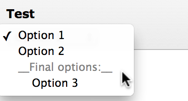
A simple selector box with a few options and a divider¶
And here's the corresponding code:
'tx_examples_options' => array (
'exclude' => 0,
'label' => 'LLL:EXT:examples/locallang_db.xml:fe_users.tx_examples_options',
'config' => array (
'type' => 'select',
'renderType' => 'selectSingle',
'items' => array (
array('LLL:EXT:examples/locallang_db.xml:fe_users.tx_examples_options.I.0', '1'),
array('LLL:EXT:examples/locallang_db.xml:fe_users.tx_examples_options.I.1', '2'),
array('LLL:EXT:examples/locallang_db.xml:fe_users.tx_examples_options.I.2', '--div--'),
array('LLL:EXT:examples/locallang_db.xml:fe_users.tx_examples_options.I.3', '3'),
),
'size' => 1,
'maxitems' => 1,
)
),
In the configuration the elements are configured by the "items" array. Each entry in the array contains pairs of label/value. Notice the third entry of the "items" array. It defines a divider. This value cannot be selected. It only helps to divide the list of options with a label indicating a new section.
Simple selector box with TSconfig markers¶
This example shows the use of markers inside the foreign_table_where property and how the corresponding TSconfig must be set up.
In the TCA definition of the "haiku" table ("examples" extension) there is a simple select field to create a reference to a page in the "pages" table:
'reference_page' => array(
'label' => 'LLL:EXT:examples/locallang_db.xml:tx_examples_haiku.reference_page',
'config' => array(
'type' => 'select',
'renderType' => 'selectSingle',
'foreign_table' => 'pages',
'foreign_table_where' => "AND pages.title LIKE '%###PAGE_TSCONFIG_STR###%'",
'size' => 1,
'minitems' => 0,
'maxitems' => 1
),
),
Without any TSconfig, the selector will display a full list of pages:
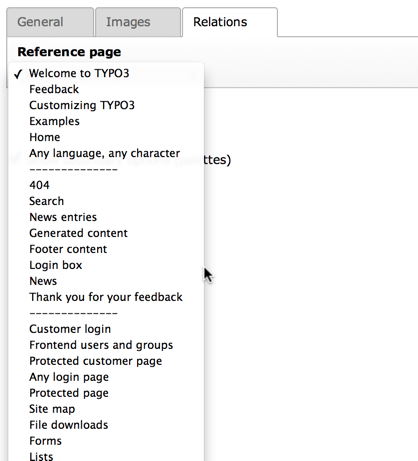
The page selector showing all existing pages¶
Let's add the following bit of Tsconfig to the page containing our "haiku" record:
TCEFORM.tx_examples_haiku.reference_page.PAGE_TSCONFIG_STR = image
The list of pages that we can select from is now reduced to:
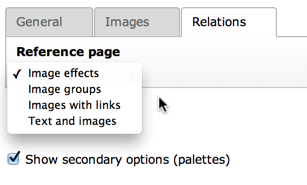
The page selector showing only pages with "image" in their title¶
A multiple value selector with contents from a database table¶
The user group selector is based on the fe_groups table. It appears as a multiple selector:

User groups selector in the access rights configuration¶
The corresponding TCA configuration:
'fe_group' => array(
'exclude' => 1,
'label' => 'LLL:EXT:lang/locallang_general.xlf:LGL.fe_group',
'config' => array(
'type' => 'select',
'renderType' => 'selectMultipleSideBySide',
'size' => 5,
'maxitems' => 20,
'items' => array(
array(
'LLL:EXT:lang/locallang_general.xlf:LGL.hide_at_login',
-1
),
array(
'LLL:EXT:lang/locallang_general.xlf:LGL.any_login',
-2
),
array(
'LLL:EXT:lang/locallang_general.xlf:LGL.usergroups',
'--div--'
)
),
'exclusiveKeys' => '-1,-2',
'foreign_table' => 'fe_groups',
'foreign_table_where' => 'ORDER BY fe_groups.title'
)
),
The value stored in the database will be a comma-separated list of uid numbers of the selected records.
An interesting point of this example is that it shows that static values can be mixed with values fetched from a database table.
Using a look up table for single value¶
In this case the selector box looks up languages in a static table from an extension "static_info_tables":
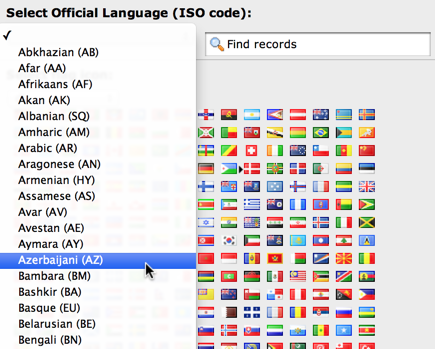
Language selector based on the static_languages table¶
The configuration looks like this (taken from the "sys_language" table):
'static_lang_isocode' => array(
'exclude' => 1,
'label' => 'LLL:EXT:lang/locallang_tca.xlf:sys_language.isocode',
'displayCond' => 'EXT:static_info_tables:LOADED:true',
'config' => array(
'type' => 'select',
'renderType' => 'selectSingle',
'items' => array(
array('', 0)
),
'foreign_table' => 'static_languages',
'foreign_table_where' => 'AND static_languages.pid=0 ORDER BY static_languages.lg_name_en',
'size' => 1,
'minitems' => 0,
'maxitems' => 1
)
),
Notice how a condition is set that this box should only be displayed if the extension it relies on exists! This is very important since otherwise the table will not be in the database and we will get SQL errors.
Render the General Record Storage Page selector as a tree of page¶
The following configuration change:
$tempConfiguration = array(
'type' => 'select',
'foreign_table' => 'pages',
'size' => 10,
'renderType' => 'selectTree',
'treeConfig' => array(
'expandAll' => true,
'parentField' => 'pid',
'appearance' => array(
'showHeader' => TRUE,
),
),
);
$TCA['pages']['columns']['storage_pid']['config'] = array_merge(
$TCA['pages']['columns']['storage_pid']['config'],
$tempConfiguration
);
will transform the General Record Storage Page selector into:
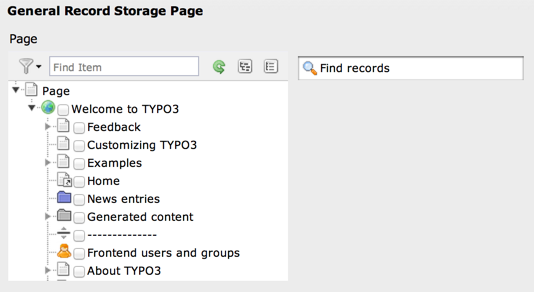
The general storage page selector modified to render as a page tree¶
Adding wizards¶
This example shows how wizards can be added to a selector box. The three typical wizards for a selector box is edit, add and list items. This enables the user to create new items in the look up table while being right at the selector box where he wants to select them:
The configuration is rather long and looks like this (note that wizards are not exclusively available for selector boxes!):
'file_mountpoints' => array(
'label' => 'LLL:EXT:lang/locallang_tca.xlf:be_users.options_file_mounts',
'config' => array(
'type' => 'select',
'foreign_table' => 'sys_filemounts',
'foreign_table_where' => ' AND sys_filemounts.pid=0 ORDER BY sys_filemounts.title',
'size' => '3',
'maxitems' => 25,
'autoSizeMax' => 10,
'wizards' => array(
'_VERTICAL' => 1,
'edit' => array(
'type' => 'popup',
'title' => 'LLL:EXT:lang/locallang_tca.xlf:file_mountpoints_edit_title',
'module' => array(
'name' => 'wizard_edit',
),
'icon' => 'edit2.gif',
'popup_onlyOpenIfSelected' => 1,
'JSopenParams' => 'height=350,width=580,status=0,menubar=0,scrollbars=1'
),
'add' => array(
'type' => 'script',
'title' => 'LLL:EXT:lang/locallang_tca.xlf:file_mountpoints_add_title',
'icon' => 'add.gif',
'params' => array(
'table' => 'sys_filemounts',
'pid' => '0',
'setValue' => 'prepend'
),
'module' => array(
'name' => 'wizard_add'
)
),
'list' => array(
'type' => 'script',
'title' => 'LLL:EXT:lang/locallang_tca.xlf:file_mountpoints_list_title',
'icon' => 'list.gif',
'params' => array(
'table' => 'sys_filemounts',
'pid' => '0'
),
'module' => array(
'name' => 'wizard_list'
)
)
)
)
),
See the wizards section for more information.

The file mount selector with add, edit and list wizards¶
Notice the configuration of autoSizeMax. This value will make the height of the selector boxes adjust themselves automatically depending on the content in them.
MM relations¶
This example demonstrates the use of MM relations. In particular they are used to relate system categories to a variety of other records. As such it is necessary to keep track in the MM table of the nature of each such record. This is achieved by using the "fieldname" field, referenced in the MM_match_fields configuration.
The "tablenames" field is also used in the case where multiple category relation fields are added to the same record type (as happens to the "pages" table when the "examples" extension is installed).
'type' => 'select',
'foreign_table' => 'sys_category',
'foreign_table_where' => ' AND sys_category.sys_language_uid IN (-1, 0) ORDER BY sys_category.sorting ASC',
'MM' => 'sys_category_record_mm',
'MM_opposite_field' => 'items',
'MM_match_fields' => array(
'tablenames' => 'pages',
'fieldname' => 'categories',
),
'size' => 10,
'autoSizeMax' => 50,
'maxitems' => 9999,
'renderType' => 'selectTree',
'treeConfig' => array(
'parentField' => 'parent',
'appearance' => array(
'expandAll' => TRUE,
'showHeader' => TRUE,
),
),
The selector looks like this:
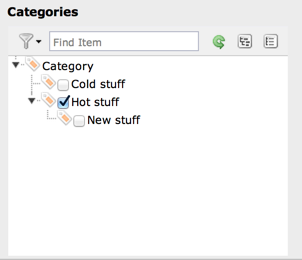
The categories selector as added by default to pages¶
The above configuration also defines the MM relation as being bidirectional, via the MM_opposite_field property. This means that we can look at a given category and see which items it is related to. Note that it is perfectly possible to create relations from that side too.
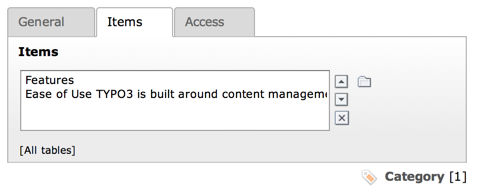
A category and the items it is related to¶
Note
The TCA configuration listed above cannot be found directly
in a TCA file, but is generated by the addTcaColumn() method
of class TYPO3\CMS\Core\Category\CategoryRegistry.
Data format of "select" elements¶
Since the "select" element allows to store references to multiple elements we might want to look at how these references are stored internally. The principle is the same as with the "group" type.
